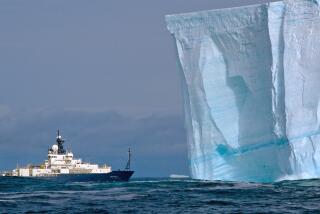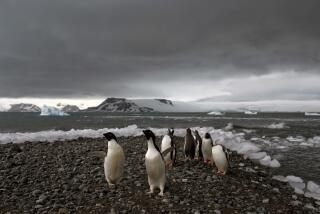Antarctic Scientists Become a Special Breed of Pioneer
- Share via
PALMER STATION, Antarctica — It can get colder than 120 degrees below zero, you are cut off from the rest of the world for much of the year and there is not a lot to do. But some people just keep coming back.
Here on the Antarctic Peninsula, at the South Pole and at other bases dotted around the Antarctic, a new breed of pioneer is pushing the frontiers of endurance and science.
Perched on the world’s most inhospitable continent, where winds reach 200 m.p.h., scientists are unraveling secrets of the world’s climate.
Scientific coups include the discovery of a hole in the Earth’s ozone layer caused by industrial chemicals. Now key work is being done on the warming of the world’s climate, the so-called greenhouse effect.
The scientists are a special breed, a mixture of back-room bookworms and Indiana Jones adventurers. Many have been coming back for years to the harshest climate on Earth.
Permanent bases boast well-equipped laboratories and living quarters, but away from the warmth of the base, scientists are on their own, living in tents in remote camps, diving into the icy sea looking for tiny shrimp-like krill or trawling the depths of Antarctic waters for elusive clues to climate change.
Supporting the scientists is an army of workers skilled in everything from cooking to computers. U.S. officials require a rigorous physical and mental examination for everyone coming here.
They join an exclusive band. About 4,000 people--more than half from the United States--live in Antarctica during the summer. The number drops sharply in the Southern Hemisphere’s winter months--February to October.
Everything is done to make them feel at home. The McMurdo Station on Ross Island, home to 1,200 summer and 180 winter residents, has bars, a 10-lane bowling alley and a gymnasium.
Even smaller bases, such as the South Pole and Palmer stations, have saunas, video libraries and pool tables.
But the people who work at the bases do not come for a vacation. They are seeking something special, something unique.
Mike Patterson, a construction supervisor, still remembers his first trip to Antarctica in 1983.
“It really felt like you were doing something not many people had done before,” he said. “Most of the people I grew up with are never going to see what I’m seeing now.”
Things have also changed over the years as concern for the environment has grown and the scientific program has expanded.
Former pastimes like ski and toboggan races, camping trips or mountain climbing are now frowned on because of the danger.
“The days of the really wild parties are over. . . . It’s a little more serious now,” said Patterson.
Certainly, it was never all fun. A study of winter staff found that they complained of insomnia, irritability, depression, stomach upsets, aggression, aches and pains and problems concentrating.
Robert Murphy, president of Antarctic Support Associates, which supplies backup staff for the science programs, said alcohol abuse and breaches of safety rules were the main concerns.
Interpersonal relationships can also cause problems.
“A quarter of the work force is female and there’s not enough to go round, so competition between the males is a problem,” Murphy said.
More to Read
Sign up for Essential California
The most important California stories and recommendations in your inbox every morning.
You may occasionally receive promotional content from the Los Angeles Times.












